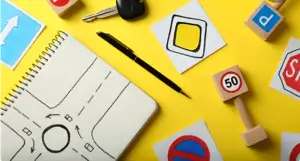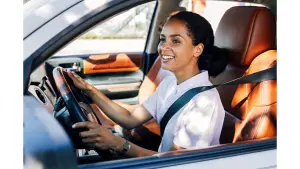When it comes to the open road, you are the captain of your own ship. Just like a lighthouse guides a ship through treacherous waters, driving safety tips can help steer you towards a smooth and secure journey.
As a responsible driver, it is crucial to be aware of the habits and practices that can keep you and others safe on the road. From buckling up to staying focused, observing speed limits to maintaining a safe distance, there are simple yet essential tips that every responsible driver should know.
By following these guidelines, you can navigate the roads with confidence and ensure a safer driving experience for yourself and those around you.
Buckle Up: Always Wear Your Seatbelt
Buckle up and always wear your seatbelt to ensure your safety while driving. It's a simple yet crucial action that can save your life. Seatbelts are designed to keep you securely in your seat during a collision or sudden stop, preventing you from being thrown out of the vehicle or hitting the windshield. They distribute the force of impact across the strongest parts of your body, reducing the risk of serious injuries.
In today's era of advanced technology and constant connectivity, it's important to address the issue of cellphone usage while driving. Using your cellphone behind the wheel diverts your visual attention away from the road, increasing the chances of accidents. Studies have shown that even a momentary glance at your phone can significantly impair your ability to react to unexpected situations on the road. Therefore, it's imperative to resist the temptation to use your cellphone while driving and focus on the task at hand: safely operating your vehicle.
Avoid Distractions: Stay Focused on the Road
To be a responsible driver, it's crucial to avoid distractions and stay focused on the road.
One major distraction that should be avoided is cellphone usage while driving. It's important to remember that visual attention plays a significant role in driving safely, so it's necessary to keep your eyes on the road at all times.
Cellphone Usage While Driving
Stay safe on the road by avoiding distractions and staying focused on the road. Texting while driving is extremely dangerous and can lead to accidents. Taking your eyes off the road for even a few seconds can have devastating consequences.
It's important to prioritize your safety and the safety of others by not using your cellphone for calls, texts, or any other activities while driving. While hands-free devices may seem like a safer option, studies have shown that they can still be distracting and reduce your reaction time.
The best practice is to simply put your cellphone away while driving and focus solely on the task at hand – driving safely.
Importance of Visual Attention?
Maintaining visual attention on the road is crucial for avoiding distractions and ensuring your safety while driving. This is especially important for children, as their visual attention skills are still developing. According to distracted driving statistics, visual distractions are a leading cause of accidents.
When your visual attention is diverted from the road, even for just a few seconds, the risk of a crash increases significantly. It's essential to stay focused and avoid any activities that take your eyes off the road, such as using your phone, eating, or applying makeup.
Observe Speed Limits: Drive Within the Designated Speed Limits
Following the designated speed limits is essential for every responsible driver. Speed limits are set for a reason – to ensure the safety of everyone on the road. By obeying these limits, you reduce the risk of accidents and protect yourself, your passengers, and other road users. Speeding not only increases the likelihood of collisions but also amplifies the severity of the consequences.
The importance of speed limits can't be overstated. They're based on careful analysis of road conditions, traffic patterns, and other factors that impact safety. Speed limits are designed to maintain a balance between efficient travel and minimizing the risk of accidents. When you drive within the designated speed limits, you have better control over your vehicle, allowing you to react quickly to unexpected situations and avoid potential hazards.
On the other hand, the consequences of speeding can be severe. Speeding reduces your ability to stop in time, increases the distance traveled during reaction time, and impairs your control over the vehicle. It greatly amplifies the force of impact in the event of a collision, leading to more severe injuries and even fatalities. Additionally, speeding can result in hefty fines, points on your driving record, increased insurance premiums, and even the suspension of your driver's license.
To ensure your safety and the safety of others on the road, always abide by the designated speed limits. Remember, responsible drivers prioritize safety over the desire to reach their destination quickly.
Maintain a Safe Distance: Keep a Safe Following Distance From the Vehicle Ahead
By keeping a safe following distance from the vehicle ahead, you ensure sufficient time and space to react to any sudden changes in traffic conditions. Maintaining a safe distance is a crucial aspect of defensive driving. It allows you to have better control over your vehicle and reduces the risk of accidents.
To maintain a safe following distance, use the 'three-second rule.' Choose a fixed point on the road, such as a sign or a tree, and start counting when the vehicle ahead passes it. If you reach that point before you finish counting to three, you're too close and need to increase your distance. This rule ensures that you have enough time to stop or maneuver safely if the vehicle in front of you suddenly brakes or swerves.
The distance required to stop your vehicle depends on various factors, such as speed, road conditions, and the weight of your vehicle. On average, it takes about 300 feet to stop a car traveling at 60 miles per hour. By keeping a safe following distance, you give yourself a better chance to react and stop in time, preventing rear-end collisions.
Use Turn Signals: Signal Your Intentions to Other Drivers
Using turn signals is an essential part of responsible driving. By signaling your intentions to other drivers, you're effectively communicating your next move on the road.
This simple action can help prevent accidents and promote safer driving conditions for everyone on the road.
Importance of Turn Signals
To ensure the safety of yourself and other drivers on the road, it's crucial to utilize your turn signals effectively. The importance of using indicators can't be overstated.
Turn signals serve as a communication tool between drivers, allowing them to anticipate and react to your intended moves. By signaling your intentions, you provide valuable information to other drivers, helping them to adjust their driving accordingly. This simple act promotes a smoother flow of traffic and reduces the risk of accidents.
Signaling etiquette is equally important. Make sure to activate your turn signal well in advance of your intended maneuver, giving other drivers enough time to react. Additionally, always remember to turn off your signal once the maneuver is complete, as leaving it on can confuse other drivers.
Using turn signals is a small but significant way to contribute to road safety.
Communication With Other Drivers
Make sure you communicate with other drivers by utilizing your turn signals effectively and signaling your intentions clearly. This is important because it allows other drivers to anticipate your next move and adjust their driving accordingly, reducing the risk of accidents.
However, it's not just about using your turn signals; eye contact and non-verbal communication also play a crucial role in effective communication with other drivers. Making eye contact with other drivers can help establish a connection and ensure they understand your intentions, especially in situations where turn signals may not be visible or may not be used properly.
Additionally, non-verbal cues such as hand signals can be used as a backup to convey your intentions in case your turn signals malfunction.
Preventing Accidents Through Signaling
Ensure clear communication with other drivers by effectively utilizing your turn signals to signal your intentions and prevent accidents. Signaling is an essential aspect of defensive driving, as it allows other drivers to anticipate your next move.
When changing lanes or making a turn, always use your turn signals in advance to give other drivers enough time to react. Proper merging techniques involve using your turn signal to indicate your intention to merge into another lane, checking your blind spot for any vehicles, and smoothly merging into the lane when it's safe to do so.
Stay Alert: Be Aware of Your Surroundings at All Times
Stay vigilant: Stay aware of your surroundings at all times while driving. One of the most important aspects of defensive driving is being aware of potential hazards on the road. By staying alert, you can anticipate and respond to any unexpected situations that may arise.
When you're behind the wheel, it's crucial to pay attention to what's happening around you. This means constantly scanning the road ahead, checking your mirrors, and being aware of the actions of other drivers. By doing so, you can identify any potential dangers, such as a car suddenly braking or a pedestrian crossing the street.
In addition to monitoring the road, it's also important to be mindful of the weather conditions and the state of the road surface. Wet or icy roads can significantly impact your vehicle's handling and braking ability. By staying alert, you can adjust your driving accordingly and avoid accidents.
Furthermore, distractions can greatly impair your ability to stay aware of your surroundings. Avoid using your phone, eating, or engaging in any other activities that take your focus away from the road. Remember, even a split second of inattention can have devastating consequences.
Frequently Asked Questions
What Are Some Common Distractions That Drivers Should Be Aware of and Avoid?
You should be aware of common distractions like smartphone use while driving and eating/drinking while driving. These distractions can have a big impact on your safety, so it's important to avoid them.
How Can I Determine the Appropriate Following Distance to Maintain From the Vehicle Ahead?
To determine the appropriate following distance from the vehicle ahead, evaluate the braking distance required for your speed and road conditions. Keep a safe distance to allow enough time to react and stop if needed.
Are There Any Specific Hand Signals That Can Be Used in Addition to Turn Signals to Communicate With Other Drivers?
Yes, there are hand signals that can be used as alternative communication with other drivers. These nonverbal signals can enhance road safety and driver communication, providing clear instructions to those around you.
What Are Some Effective Strategies for Staying Alert and Avoiding Fatigue While Driving?
To stay alert and avoid fatigue while driving, there are several effective strategies you can use. These include taking regular breaks, getting enough sleep, staying hydrated, and avoiding distractions like your phone.
How Can I Improve My Overall Awareness of My Surroundings While Driving?
To improve your overall awareness while driving, focus on minimizing distractions. Keep your eyes on the road, limit phone use, and avoid multitasking. Stay alert and attentive to your surroundings to ensure a safe driving experience.






